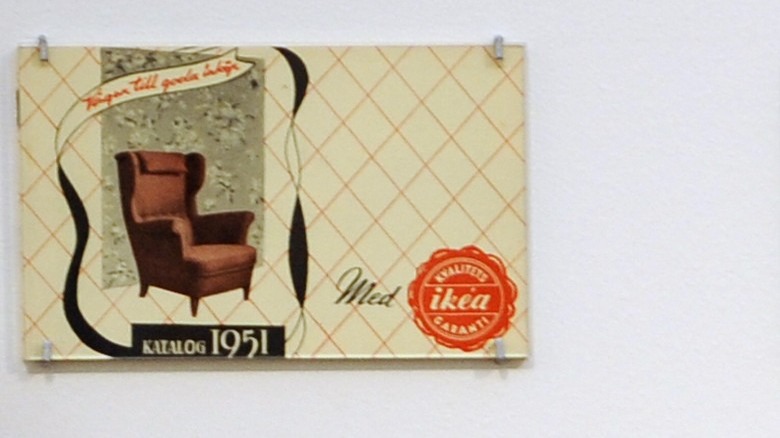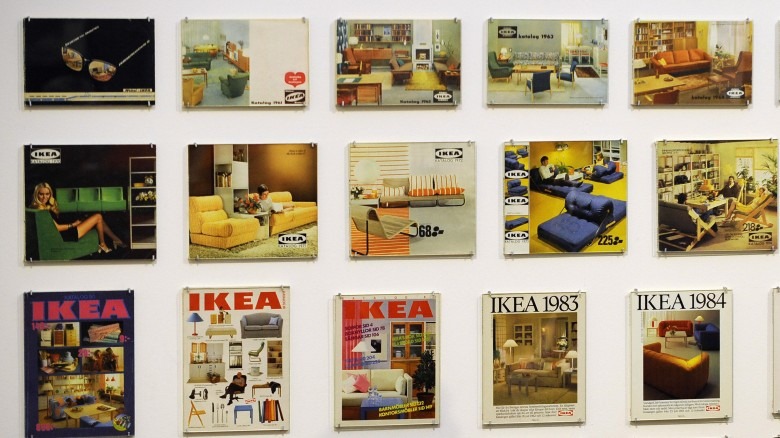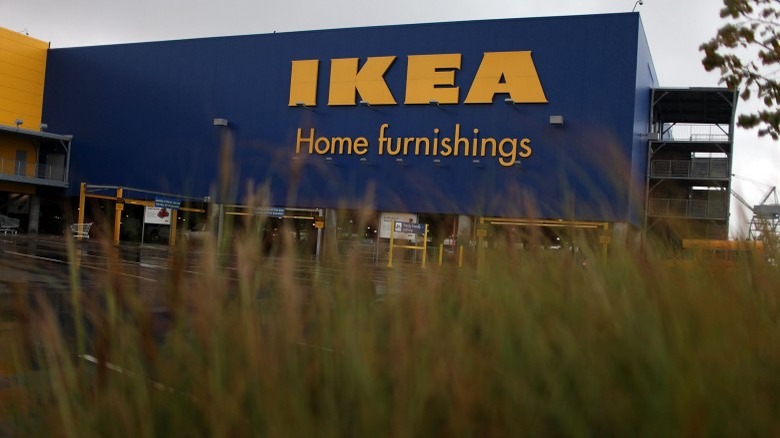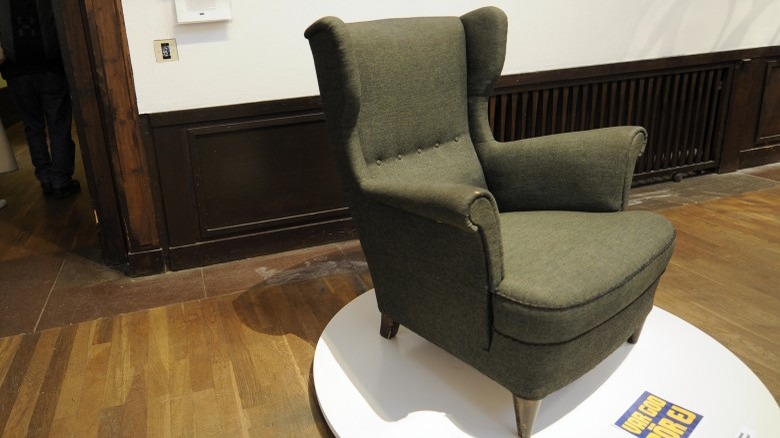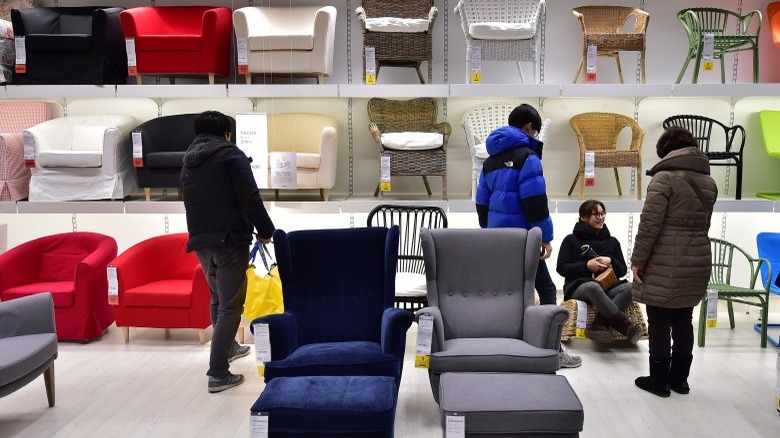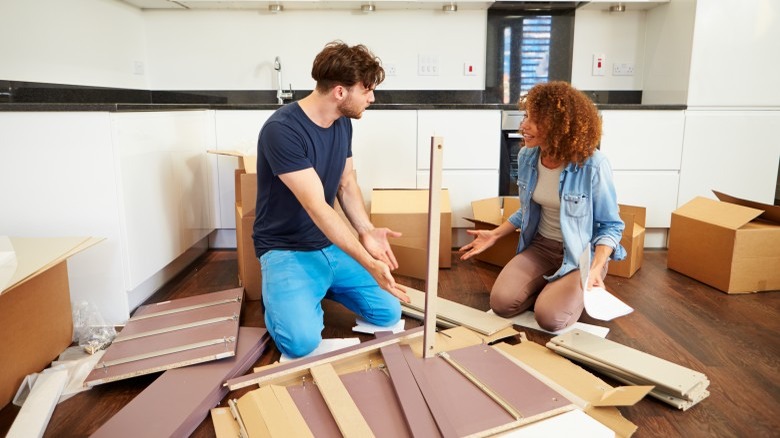The Untold Truth Of IKEA
IKEA has become a staple of affordable furniture, but there's a lot more to this chain than Allen wrenches and Köttbullar — aka, meatballs. Seemingly synonymous with college students and recent grads, it's revolutionized the furniture industry, influenced home decor, and is still rapidly growing.
So, as the retail giant takes over the world, let's take a look at the (ready-to-assemble) untold truth of IKEA.
The founder started selling things at age six
Ingvar Kamprad, the founder of IKEA, didn't have an affluent start in life. He grew up on a very poor farm in Elmtaryd, Agunnaryd, Sweden. His family had to work hard to make a living, and that included Kamprad, even as a child. His entrepreneurial nature began to blossom at age six, when he started selling matches around the neighborhood.
By age 10, according to Sweden.se, he'd expanded his business. Kamprad sold Christmas decorations, fish, and pencils, and delivered them throughout the neighborhood from his bicycle. Perhaps those early sales days later inspired IKEA's eclectic selections.
Kamprad started IKEA at 17 and named it after himself
When he was 17, Kamprad's father rewarded him for doing a good job in school. And this wasn't some "everyone gets a ribbon" kind of parenting. Kamprad was dyslexic and his success in class did not come easily. So, his father gave him a little bit of money for his excellent marks.
But instead of blowing it all on movies and clothes like an average teenager, Kamprad started his own business. Not content to sell the winning combo of Christmas ornaments and fish forever, in 1943 he founded IKEA, which stood for "Ingvar Kamprad" from "Elmtaryd, Agunnaryd," basically his name and his hometown. That's probably why you never had success finding out what "IKEA" meant, in your Swedish-English dictionary.
The item names are a product of Kamprad's dyslexia
One of the most notable aspects of IKEA furniture are its great Scandinavian names. Isn't it more fun to order an "Ektorp," rather than a plain old sofa? Well, IKEA didn't decide to give their products quirky titles just for fun. The naming system is actually a product of Kamprad's dyslexia.
Usually products would simply go by number, but due to his dyslexia, numbers were difficult for Kamprad to handle. So, he gave everything a name. Most of the IKEA product titles are names of Swedish, Danish, and Finnish places, though there are some Swedish words thrown in, too. For example, Expedit (a name of a bookshelf) means "shop assistant." Perhaps the most famous of all product names is Billy, the plain bookcase owned by every college grad. It got its name from employee Billy Likjedhal. I wonder if he uses his furniture fame as a pick up line? "Hey, that bookshelf you have? Yeah, that's me." He must get all the ladies.
No one knows how much Kamprad makes
It's clear that Kamprad makes a pretty good living since the lowest estimate of his net worth comes in at $3.5 billion, according to Fortune. But no one but Kamprad knows exactly how much he makes from the company. Since he doesn't technically own the IKEA Group or Inter IKEA, the companies that handle the stores and brand respectively, his financial information is unclear.
In fact, IKEA's financial structure is designed to hide who all the money is going to. The bright people at Fortune magazine couldn't even figure it out. If anyone wants to pry the information from Kamprad's sons' hands, good luck. According to the magazine, his three sons have never given a single interview even though they're directly involved in the running of IKEA. So, financial forecasters just have to guess at Kamprad's worth, which according to Fortune, could be as much as $42 billion. That'll get you a lot of Billy bookshelves.
IKEA's American debut was a total flop
There was a time when IKEA wasn't omnipresent in America. In fact, their first attempt at American business went pretty badly. In 1985, they opened a store in King of Prussia, PA, just outside of Philadelphia. Everything was measured in centimeters and a lot of the sizes didn't suit American tastes. For example, the store sold tons of vases, not because Philadelphians got really into flowers that year, but because they used them as drinking glasses. The actual glasses were much too small, since IKEA didn't anticipate the love of iced beverages in the U.S. A former executive told Fortune, "We thought everything was going to be easy, and it was hell."
According to The New York Times, in 1992, IKEA considered pulling the plug on American efforts all together. Luckily, they decided instead to delve into intense market research to really find out where they went wrong. Now, IKEA places a premium on market research when expanding into new territory. Head of research Mikael Ydholm said in Fortune, "The [farther] away we go from our culture, the more we need to understand, learn, and adapt." With this new method of analyzing cultural differences and needs, IKEA has been able to open stores all around the world.
They'll send a live-in anthropologist to study you
How exactly do they delineate specific cultural differences? Even if you read every book on South Korea, you probably won't find that they prefer, say, metal chopsticks. But IKEA learns all of those details because they take research seriously. Really seriously. According to Fortune, they'll even send an anthropologist to live with a family to learn about their customary home life.
Plus, IKEA does regular home visits to see your furnishing habits and even installed cameras in people's houses in Stockholm, Milan, New York, and Shenzhen, China. Though that might sound a little invasive for a store that sells laptop tables and plastic dishes, they do these things with the consent of volunteers, only. And through this extremely specific knowledge, they've been able to become one of the biggest retailers in the world.
One of the tidbits they found from footage of Shenzhen was that people mostly used their couches as backrests, while they sat on the floor. Ydholm told Fortune, "I can tell you...we for sure have not designed our sofas according to people sitting on the floor and using a sofa like that." Well, maybe not yet anyway.
IKEA's entertainment center with built-in TV was a fail
Despite their many successes, IKEA is not impervious to failure. In 2012, the retail giant debuted the Uppleva, an all-in-one entertainment system that contained an HDTV and blu-ray player. It sounded great, but the results? Not so good.
Gizmodo reported on translated reviews from M3 in Sweden (who got the first look at Uppleva) that claimed the furniture itself was perfectly nice and easy to put together, but the electronics were pretty awful. The TV had poor image quality, and though it could interface with the internet, it did so insanely slowly — and sometimes button presses would just do nothing. For $1000, people expected a lot more. Not surprisingly, the set is no longer sold, though you can still get an Uppleva wall mount, if you're really dedicated.
They're building a village in London
Even though they may not take over the electronics industry, IKEA might be taking over the world. In addition to their 340 stores worldwide, they've begun building a village in East London. Called Strand East, the suburb will sit on 27 acres and have houses, apartments, non-chain stores, and no IKEA. Despite owning the little town, there are no plans for a signature store in that location.
Plus, the 6,000-person community, according to Architizer, plans to be nearly car-free, clean, and designed to produce long term profits for the company. Early projections said the community would be open by 2013, but as of 2017, it's still in development.
Germans love IKEA so much they wrote a musical about it
You might think Sweden would be IKEA's number one customer, but that honor goes to Germany. Germans make up 15 percent of all IKEA's sales. It's become such an important part of German life, that they wrote a musical about it called Wunder von Schweden (Miracle of Sweden).
Sadly, it doesn't feature any songs like "Where did that one screw go" or "These illustrated instructions are impossible." Instead, it tells a fictionalized version of Kamprad's life through Swedish folk songs. Also, according to a translated page from Rowohlt, it was a satire of market economies and cast Kamprad as a savior figure to bring to the world a version of "benevolent capitalism." By all accounts, the IKEA musical went pretty deep. Looking for clips online? Subsequent productions have also gone under the name Ingvar!
In Europe, you can buy IKEA houses
Part of the reason why Germany might love IKEA so much, is that Europeans are getting a few extra things we can't get in America. In Europe, IKEA sells actual houses. Yes, you can really buy a home that's made by IKEA, in prime IKEA style. Called the BoKlok concept, their goal is to provide affordable housing. As the BoKlok website once described it, "The idea of our concept is — in short — that our customers should get as much house as possible, for as little money as possible."
You can live in a BoKlok block of flats — basically an apartment building that's guaranteed to give you some access to a yard or outdoor space — or, the slightly larger Terraced House. But if you're looking to buy your own IKEA mansion, look someplace else. These living spaces are designed to be small, efficient, and green. In Sweden, there are over 100 BoKlok developments. They've also branched out into Finland and the UK, though in the UK, BoKlok was not so popular. In 2009, the Independent reported that of 36 apartments built, 20 remained empty. Though a lot of incentives were offered (free gym memberships, legal fees paid, and a free family vacation) interest just wasn't there.
It changed the furniture industry
Before IKEA, most people thought of furniture as a major purchase. It was meant to last for years and years, potentially handed down through the generations. IKEA changed that idea completely. They made furniture that was much more affordable and if it didn't last for 20 years, who cared? It was easy to go buy another.
Warren Shoulberg, a retail expert at the Robin Report, claims that IKEA is responsible for the change in retail from long term goods to cheaper, throwaway products. H&M, Zara, and Uniqlo all feature a similar model, one that didn't exist before IKEA set its meatballs in the retail world.
It causes relationship problems
One experience you may have had in an IKEA, other than wanting to take a nap on all of their comfy beds, is a fight with a significant other over what chairs to buy. Actually, lots of people complain about arguments in IKEA stores and if it seems like the store is almost arranged to cause people to fight? That might (accidentally) be true.
According to The Science of Us in New York Magazine, the overwhelming amount of choices already puts us in an anxious state. Then, if an argument starts over one of the many choices, that begets a cycle of frustration. Lastly, when you get out of the store, you have to put the stuff together, which can be the most aggravating task of all. All these factors put together make IKEA and pretty terrible date idea, testing even the best of relationships.
IKEA is switching to no-screw assembly
Luckily for everyone that's fretted over a lost Allen wrench or mysterious extra washer, IKEA is switching to an even simpler form of assembly. Maybe you're well aware that IKEA products usually come with a lot of fittings (screws, nuts, etc.). Well, that's about to change. The range and supply manager Jesper Brodin told Dezeen, "So we thought, what happens if we try to take [fittings] out totally? We are now into the implementation phase of making it possible for you to click your furniture together." IKEA dreams coming true, thanks to the new wedge dowel. Brodin said, "I actually put together a table which used to take me 24 minutes to assemble, but took me three minutes to click together."
For now this amazing wedge dowel technology will only be available for the Lisabo table, but they plan to make all furniture "click-together-able" in the near future, according to Dezeen. So, if you're ever disappointed by the news in 2017, just remember this moment when IKEA solved our greatest collective furniture dilemma.
IKEA does not like people spending the night in their stores
Spending a day looking at all IKEA's comfy beds and couches would make anybody want to spend the night. But a rash of unwanted sleepovers has upset the furniture giant. In August of 2016, two Belgian teens hid out and spent the night at IKEA and the YouTube documentation of their adventures got over 2.5 million views. The Guardian reported that ten instances of covert sleepovers occurred all over the world by December of 2016. IKEA spokeswoman Johanna Iritz told The Guardian that the company wants people to stop hiding in stores because "we can't guarantee safety."
I wouldn't recommend attempting your own secret IKEA vacation, but if you must, don't try it in Sweden. Göteborgs-Posten (translated and reported by The Local) spoke to IKEA's Emil Eriksson who said, "Staying in the store is not allowed and [is] something we at Ikea take seriously. Our policy is to search the store before closing. All our stores in Sweden are equipped with motion detectors to ensure everyone's safety." Sweden's not messing around, so make sure to play by IKEA's rules on their home turf.
IKEA: the giver of good, cheap furniture
Though it's easy to make a lot of jokes about IKEA, they've actually done quite a service to the industry. They made a formerly expensive part of living into an affordable and easily-accessible shopping experience. You may take your Billy shelf for granted now, but remember that IKEA made your simple, flat-packed, post-grad apartment possible.
The fact that the company continues to make affordability a priority over profit, is pretty incredible. So, go — enjoy your nearest IKEA and grab yourself a jar of lingonberry jam. Smaklig måltid (— or, bon appétit)!


